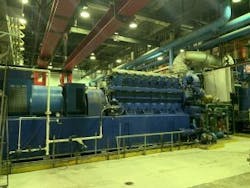A new microgrid serving Kings Plaza shopping mall in Brooklyn, N.Y. kept operating through a Consolidated Edison (ConEd) blackout last summer and helped the utility restart after the outage.
Generator at Kings Plaza. Courtesy of Veolia
The microgrid consisting of oil and gas fired engines was completed in May after the owners decided to convert a 12-MW stand-alone power system to a system connected to the grid, said Mike Byrnes, senior vice president for Veolia’s municipal and commercial business and CEO of Veolia’s Source One business. Veolia provides waste, water and energy solutions in an effort to boost its clients sustainability. Source One is an energy consulting firm serving commercial, industrial and municipal organizations.
With the new microgrid, the 1.1 million square foot, 50 year old mall participates in income-earning demand response events, boosts resilience and improves efficiency, said Byrnes. The payback on the mall’s multi-million dollar investment is about five years, he said.
Over the summer, after a ConEd blackout in Brooklyn, the microgrid kept serving the mall and helped the utility restart operations. “We were one of the first to give grid support when ConEd turned back on,” said Byrnes. “When you go back on, more points of power going into the grid makes it more stable.”
The project has its roots in the 1970s, when Kings Plaza’s owners built a stand alone power plant. At the time, ConEd’s distribution system couldn’t meet the energy requirements of the mall.
Motivated by demand response
“You had to pay ConEd to connect to the grid, or build your own plant,” he said. “Many chose to build their own plants.”
The Kings Plaza system at the time consisted of four units, 3 MW each, powered by natural gas and diesel. They provide central chilling and heating.
“It wasn’t quite a microgrid at that point,” said Byrnes.
Veolia, which operates the plant, concluded recently that it made sense to connect to the grid. One of the main reasons was new demand response programs from ConEd that would allow the mall to earn income.
Another was the inefficiency of the existing system. With the four 3 MW engines, one had to be in spinning reserve at all times in case others went down, so the plant ran below peak efficiency levels.
With the stand alone system, if the load was 4 MW on a typical day, the plant operators ran at least three engines to ensure there was backup.
“If I ran two engines at 2 MW, and if one tripped, the other engine would trip off with it and the mall would be blacked out,” he said. The plant usually ran with three engines operating at less than their total capacity.
Advantages of the new microgrid
“Running at one third of the loading, the heat rate is higher, and efficiency is lower. There are more greenhouse gases.” said Byrnes. “We started looking to see if the (demand response) programs made sense if we connected to the grid. We could get operational efficiency and resilience and have the grid as our backup,” he said.
To allow the microgrid to connect to ConEd, Veoila added switchgear, a small substation and other equipment. The mall now can run two engines at peak efficiency while buying from the grid and selling power to ConEd, he said.
At this point, the mall provides about 6 MW to ConEd. If the microgrid goes down, the microgrid operators can switch over to ConEd.
Another advantage of the microgrid is the ability to choose among power sources. Sometimes ConEd power is less expensive than power from the microgrid, said Byrnes. “For all of October it was cheaper to buy power from ConEd than to make it ourselves,” he said.
Switchgear installed by Veolia at Kings Plaza. Courtesy of Veolia
Similar commercial microgrids coming to Brooklyn
Other companies located in the Brooklyn area plan to convert their stand alone systems to microgrids. Veolia is now working with a major apartment complex that has a stand alone power plant but wants to connect to ConEd.
Like the mall microgrid, the other microgrid is expected to boost efficiency and lower greenhouse gas emissions, all the while improving resilience.
Track news about new microgrid projects. Subscribe to the free Microgrid Knowledge newsletter.








